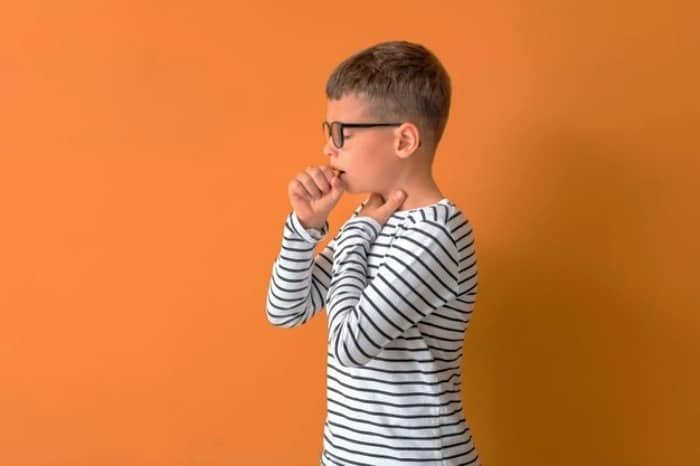All causes, symptoms, prevention, and treatment methodsInfluenzain Children
Influenza is a type of respiratory infection caused by the influenza virus. It typically spreads once a year among people, peaking between November and April. The influenza virus often changes from year to year, meaning people cannot develop long-lasting immunity, which is why someone can catch influenza more than once a year. Influenza is unlikely to spare anyone in a year; in other words, no one can completely avoid it.
This disease can occur in individuals of all ages, but it is particularly dangerous for children.
How does influenza spread?
The influenza virus is present in the nose and throat, and children can catch it from siblings, parents, family members, playmates, and others.
The infection and virus enter the body through three main pathways:
– Direct contact:
Such as kissing, touching, or shaking hands with an infected person.
If you are infected, germs can be found in your nose, mouth, eyes, or on your skin and can spread by touching others.
– Indirect contact:
This means touching something, such as a toy or item that has been touched by an infected person and now has germs on it. Germs can also be transferred fromthe common coldanddiarrheato other individuals.
– Germs stay in the air and can be spread when a person sneezes andcoughs.How can we tell if a child has influenza?
Influenza can strike like a cold or may be even worse. Children with influenza typically lack the energy to engage in their daily activities and tend to stay in bed.
Common symptoms of influenza include:
Sudden fever
- Fever and chills
- Headache
- Muscle pain
- Extreme fatigue
- Dry cough
- Sore throatLoss of appetite
- Dizziness
- Ear pain
- Individuals with influenza can exhibit various symptoms:
Newborns may only show high fever from influenza, sometimes severe enough to not be described, and may have no other symptoms of the illness.
- Children with fevers above 39.5 degrees may be affected.
- Stomach pain
- vomiting, and diarrhea are also common symptoms of influenza in children.Watery eyescan also be among these common symptoms.In some cases, muscle pain may occur in an individual.
- Can influenza cause complications and problems?

Most people do not experience serious issues after influenza. Fever and muscle pain usually last only 2 to 4 days, but cough and fatigue can persist for one to two weeks or longer.
Influenza can also lead to complications such as throat and vocal cord infections, causing wheezing and coughing, lung infections,
bronchitisand narrowing of the airways.It can also weaken the immune system and cause bacterial infections in the ears, lungs, and sinuses.
Influenza is more severe in children under 2 years old, and those with chronic issues like heart, lung, and neurological problems are at higher risk.
Influenza can rarely cause problems with the brain and heart.
When should I see a doctor?
If your child is under three months old and has influenza, you should definitely contact a doctor. The following conditions may arise:
Breathing difficulties
- Not eating or vomiting
- Fever (higher than 38.5 degrees)
- If your child exhibits any of the following issues, contact a doctor immediately:
Rapid breathing that sometimes makes breathing hard.
- Chest pain or coughing up blood
- Severe coughing leading to
- nauseaand vomitingDrinking little water and not urinating for at least 6 hours after waking up
- Vomiting and nausea lasting more than 4 hours or severe diarrhea
- Excessive drowsiness and lack of appetite
- Feeling unwell after 5 days, high fever, or if you believe a new illness is developing or a chronic disease is emerging.
- If your child exhibits the following symptoms, take them to the hospital immediately:

Difficulty breathing
- Blue or discolored lips
- Inability to move
- Difficulty waking and unresponsiveness
- Stiff neck
- Confusion
- Seizures
- What should I do if my child has influenza?
Make your child as comfortable as possible, provide ample fluids, and ensure nutritious meals for them.
- If they have a fever, dress them lightly and keep the room temperature around 20 degrees Celsius.
- For pain or fever above 38.5 degrees, use
- acetaminophen.Ibuprofen can also be given to children over 6 months old unless a doctor has advised otherwise, and all medications should be taken according to the dosages specified by the doctor. Never give your child aspirin or products containing it, as it can harm the brain and liver.Do not use over-the-counter cold and cough medications for your child, especially if they are under 6 years old.
- Always speak with your doctor or pharmacist to check for interactions between influenza medications and others. Read the directions on the medication label carefully and never exceed the recommended dosage.
- Coughing helps to clear chest mucus. Many flu medications contain ingredients that help relieve cough, usually including dextromethorphan and diphenhydramine, which are typically prescribed for teenagers and have shown no benefit for children.
- Gargling with warm water can soothe a sore throat: Children three years and older who have learned to eat should avoid sugary foods and substances, such as honey,
- herbal remedies.or pectin. Medicines such as dyclonine, benzocaine, hexylresorcinol, menthol, and phenol should not be prescribed for young children as they can cause swallowing difficulties.Antiviral drugs: If your child has respiratory or heart problems, this illness could affect their immune system or other chronic conditions, requiring careful attention. Consult a doctor before taking antiviral medications. Amantadine, oseltamivir, and zanamivir are antivirals that can combat influenza and are prescribed for individuals with influenza who are otherwise healthy. Typically, these medications are most effective when taken within 48 hours of symptom onset.
- How can I prevent the flu?

Influenza can be prevented through vaccination: Individuals over six months old should receive a flu vaccine every year, particularly important for children at higher risk of influenza or who have chronic illnesses.
- If your child is under 5 years old or has a chronic condition, all family members should get vaccinated. Since children of this age cannot be vaccinated, those around them should be vaccinated to avoid transmitting the illness.
- Handwashing is one of the most important ways to reduce virus spread.
- Wash your hands after coughing, sneezing, or blowing your nose.
- Wash your hands after contacting individuals with respiratory infections.
- Wash your hands after blowing your child’s nose.
- When soap and water are not available, use alcohol-based sanitizers or wet wipes and keep your clean hands away from your child to avoid contaminating them.
- As much as possible, keep children under three months away from colds and cold-suffering individuals.Teach your child to cover their nose and mouth when coughing and sneezing with a tissue or to cough into their sleeve or clothing to contain their virus.Ensure your child does not put toys in their mouth and keep their items clean.
- Avoid sharing cups, mugs, and towels with anyone else.
- If your child needs care, try not to take them out of the house.
- Make sure your child has received all necessary vaccinations, which will help prevent complications like bacterial infections in the ears and lungs later on.
- Difference between a cold and influenza:
- These two illnesses are often confused, yet they have many differences. The viruses for these two types of illness are different, and there is no real treatment for a cold; instead, measures taken for colds are merely to control symptoms of influenza. However, influenza results from a virus related to the influenza family, and treatment is available for it.
- Influenza has symptoms like headaches and problems such as nasal congestion, cough, sore throat, and muscle pain. Influenza can also cause diarrhea, vomiting, and high fevers.
Influenza symptoms in children exceed wheezing and coughing, with these symptoms usually starting two days after exposure to the virus.
Children with influenza types A and B usually have seasonal influenza.
Children with influenza type C may also show the following symptoms:
Watery eyes
Red eyes
nasal congestion, sore throat, and skin issues
- Anxiety
- Influenza type C is typically mild and does not spread to other people.Influenza can pose serious risks and threaten life and is generally worse than a cold; this viral infection can spread rapidly, so do not hesitate to consult a doctor.
- Never give your child medications like aspirin without consulting a doctor.
Get enough rest: sufficient rest helps individuals recover faster.
Your doctor may also recommend increasing fluid intake in such circumstances.
How long does influenza last?
- Most influenza illnesses are shown by symptoms lasting 5 days or less, after which cough and body weakness may start. With appropriate treatment, influenza symptoms can clear up within two weeks.
- At times, difficulties from this illness may last over four or five weeks; if not taken seriously, the individual’s condition can worsen and may result in pneumonia or other respiratory illnesses.
Now, we can consider the home remedies mentioned in this section of
SelMagz
that have no side effects.
Home remedies for influenzaHome remedies can relieve influenza in individuals but do not completely eliminate the virus. Here are some examples:1. Drinking plenty of water
Your child may refuse to drink water or may experience difficulty swallowing due to sore throat and nausea. This can lead to dehydration, delaying their natural recovery, so make sure to encourage your child to drink enough water daily.
2. Consuming soup
Hot liquids such as
soups
and warm lemon water can serve as suitable home remedies for soothing the throat and easing soreness.
Chicken soupis a traditional dish used for quick influenza recovery that you can give your child once or twice a week to combat their immune weakness and fight the virus present in their body. Hot liquids help reduce nasal and throat inflammation.3. RestingThe immune system requires energy to fight the influenza virus. This is also one of the main reasons that individuals with influenza feel tired. Provide your child with as much restful time as possible and allow them to act lazily to conserve energy for battling the virus.4. Warm compress

If your child suffers from severe headaches, you can apply a warm compress to their forehead. Place a warm towel over their head and press it lightly against their forehead.
5. Gargling
The influenza virus can cause lung issues and make breathing difficult. Gargling with warm water can help remove excess mucus and soothe their sore throat.
Mix a glass of warm water with a spoon of salt and let your child gargle this liquid for at least 5 minutes and repeat this four times a day.
You can also dissolve some
apple cider vinegar
in warm water and gargle it daily.
Gargling with herbal tea or with water andhoneycan improve throat condition.
6. Steam inhalationSteam inhalation can also clear an individual’s nasal passages and chest. You can do this by giving your child a warm shower within enclosed doors, helping to remove excess mucus.You can also boil some water and add some
rosemary
to it. Then, place your face above the steam for five minutes and have your child breathe it in.
When using a humidifier, change the water daily to avoid air contamination in the room.7. Eat appropriate and healthy foodsEating the right foods can act like medicine against influenza, and you can fight the influenza virus by drinking plenty of water and consuming suitable foods.
Foods rich in
vitamin C
can strengthen the immune system and assist in cleansing the lungs. Examples include oranges,
- green vegetables, lemons, andgrapefruit.Honey is also a nutrient-rich antibacterial and antimicrobial substance that helps relieve throat pain during influenza. You can mix a spoonful of honey with lemon in warm water and give it to your child twice a day, or you can give your child 10 grams of honey before bed to ease their cough.Ginger can also reduce throat pain and coughing: boil a small amount ofgingerin water and give it to your child two to three times a day.Garlic is also a complex allicin that has antimicrobial properties and is effective in combating the influenza virus. If your child cannot chew a clove, you can add some of it to their soup.You can also use herbal remedies and herbal teas to boost immune system efficiency, improving symptoms.The probiotics in
- yogurt
- are beneficial bacteria that keep the immune system healthy. A healthy immune system fights the influenza virus more effectively.Vegetables also contain vitamins and minerals that provide the energy needed for the body to combat the virus, and you can incorporate these vegetables into your child’s daily meals.Oranges are also rich in vitamin C, and a glass of
- orange juice
- when consumed daily can enhance the body’s ability to fight against influenza.
- Bananas are rich inpotassiumand can help relieve nausea sensations.
- Other tips
- If ignored, influenza can lead to complications and diseases such as asthma, heart problems,diabetes,and more.
- This illness, when treated with medication in children, can improve within 3 to 5 days, while in older children between 8 to 12 years, it may take one or two weeks.There is no influenza vaccine for infants between 0 to 6 months, but these children are at a high risk of infection.Stomach pain
Stomach pain is one of the symptoms of influenza.
Loss of appetiteLoss of appetite can indicate the severity of the influenza illness.Cough
Using cough syrup
Soup







